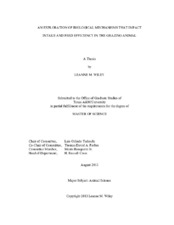| dc.description.abstract | Biological mechanisms that potentially contribute to residual feed intake (RFI) have not been fully understood in the grazing animal. The objective of this study was to determine the differences of RFI measured in confinement (RFIc) or grazing (RFIg) on animal performance. Animals were previously classified in confinement as high RFI (HRFIc), or low RFI (LRFIc) and subsequently under grazing as high (HRFIg) or low (LRFIg). Effects of forage quantity on dry matter intake (DMI), and biological mechanisms that contribute to variations in RFI were investigated using ultrasound, carcass traits and bacterial populations.
Bulls were allotted to replicate bermudagrass pastures at low (LSTK) or high (HSTK) stocking intensities and heifers grazed one Ryegrass pasture. Ruminal microbial content was collected and profiled using bacterial tag-encoded FLX amplicon pyrosequencing technique. In 2009, bulls were harvested directly off the pasture and ultrasound and carcass measurements were determined. Data were analyzed using PROC GLIMMIX of SAS. Linear regressions were obtained using PROC REG to estimate RFI.
In 2009, there was a difference for LRFIc bulls in F:G (P=0.032), and HRFIg bulls on LSTK had an interaction for ADG (P=0.043). HRFIg bulls had greater intakes regardless of STK (P=0.003). In 2010, HRFIc bulls remained heavier throughout with the greatest DMI (P=0.0095). There were no differences for any traits for 2010 RFIg bulls. At a LSTK, HRFIg bulls tended (P>0.05) to have a lighter gastrointestinal tract (GIT) weight (P=0.093) while liver weight (P=0.072) tended to be heavier for all bulls. The small intestine was heavier for LRFIg bulls (P=0.09) on a HSTK. There was an interaction for microbial bacteria identified in the rumen in 2009 on hemicellulolytic (P=0.048), starch (P=0.025), and pectinolytic (P=0.057) degrading bacteria. HRFIg bulls at a LSTK had a greater percentage for amylolytic and pectinolytic degrading bacteria (P=0.008 and P=0.051, respectively) in the large intestine. There were no interactions for any substrates in 2010.
DMI (P<0.0001) was greater each year for HRFIc heifers and was greater (P=0.0168, P=<0.0001, P=<0.0001) each year respectively for LRFIg heifers. No differences were found for initial BW, final BW, MetBW, and ADG in the RFIc or RFIg classes.
HRFIg bulls with the greatest forage availability consumed more and had heavier GIT, but it is still unclear how the microbial fauna affected the efficiency among RFI phenotyped bulls. | en |


